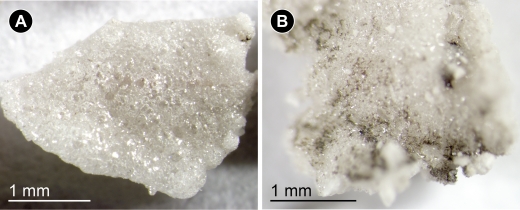Water delivery to the inner Solar System is crucial for life to develop, for worlds like our own must have formed dry, well within the ‘snowline.’ We need a mechanism to bring volatiles from the ice-rich regions beyond 3 AU or so, and while much attention has been paid to comets, we’ve been learning more about asteroids as a second delivery option, for isotopic measurements have shown that Earth’s water has similarities to water bound up in carbonaceous asteroids.
Focusing on asteroid delivery, Pete Schultz (Brown University) and colleague Terik Daly, a postdoctoral researcher at Johns Hopkins University, have confronted the issues raised by early system impacts in a series of experiments. The results appear in the journal Science Advances. Says Schultz:
“Impact models tell us that impactors should completely devolatilize at many of the impact speeds common in the solar system, meaning all the water they contain just boils off in the heat of the impact. But nature has a tendency to be more interesting than our models, which is why we need to do experiments.”
Daly and Schultz found the equipment they needed to study volatile delivery at the Vertical Gun Range at NASA Ames. Their methodology was to fire marble-sized projectiles similar in composition to water-rich carbonaceous chondrite asteroids at a dry target made of pumice power. The speed at impact is some 5 kilometers per second, producing debris that can be analyzed in search of water traces.

Image: Hypervelocity impact experiments, like the one shown here, reveal key clues about how impacts deliver water to asteroids, moons, and planets. In this experiment, a water-rich impactor collides with a bone-dry pumice target at around 18,000 kilometers per hour. The target was designed to rupture partway through the experiment in order to capture materials for analysis. This high-speed video, taken at 130,000 frames per second, slows down the action, which in real time is over in less than a second. Credit: Schultz Lab / Brown University.
The results are a useful window into water delivery. The heat of the impact destroys much of the impactor, while a vapor plume then forms that contains water that was inside the impactor. Inside the plume itself, melted materials and breccias — particles of shattered rock re-formed within a fine-grained matrix — contain some of the original water in recaptured form.The original impactor may be gone, in other words, but a portion of its internal water can survive.
The implications for the early Solar System are clear, as the paper notes:
The fact that the amorphous, glassy component—not projectile survivors—constitutes the primary reservoir for impact-delivered water is critical for extrapolating these experiments. Impact melt production increases with impact speed. If impact melt derived primarily from the target successfully traps water during collisions among planetary bodies (as it does in experiments), then higher-speed impacts may still deliver significant quantities of water.

Image: Samples of impact glasses created during an impact experiment. In impact experiments, these glasses capture surprisingly large amounts of water delivered by water-rich, asteroid-like impactors. Credit: Schultz Lab / Brown University.
The authors calculate that carbonaceous chondrite impactors should be able to deliver up to 30 percent of their internal water to silicate bodies under conditions of impact speeds and angles that we would expect during the early phases of planet formation. Impacts at velocities high enough to vaporize the volatiles still allow for the recapture of those volatiles through impact melts and breccias, so water can be incorporated into the growing planetesimals.
“[T]hese new experiments raise the possibility that growing terrestrial planets trap water in their interiors as they grow, which would profoundly affect their geodynamical evolution,” the authors write. It’s a finding that also helps us explain water distribution later on in the system, such as water ice found on the Moon’s surface in the rays of the Tycho crater, or asteroid-derived water that could account for ice deposits in the polar regions of Mercury.
“The point is that this gives us a mechanism for how water can stick around after these asteroid impacts,” Schultz adds. “And it shows why experiments are so important because this is something that models have missed.”
The paper is Daly & Schultz, “The delivery of water by impacts from planetary accretion to present,” Science Advances Vol. 4, No. 4 (25 April 2018). Full text.



Given the characteristics of the exoplanet population, the question of how not to get water into the inner Solar System also seems relevant.
Quite an interesting point!
Interesting, gravity might not help very much to retain the water since planetesimals are only kilometer sized and have a low escape velocity. The kinetic energy and depth of the impact into the planetesimal might help retain water like this experiment since a kilometer sized target has a kilometer of depth.
This story reminds me of a scientific scuffle back in the 90’sregarding whether “small comets” existed purported to be about 20-30 feet across and consisting of nearly pure water but quite fluffy. Per satellite imagery, hundreds were hitting the upper atmosphere daily and these comets could account for the earth’s water over billions of years of accumulation. A lot of arguments were advanced against the claims and it seems that the small comet hypothesis has faded away.
For:
https://science.nasa.gov/science-news/science-at-nasa/1997/ast09dec97_2
Against:
http://www.spacedaily.com/news/comet-99e.html
What about ocean impacts? The Earth and many of the earth size to super earth sized exoplanets will have large oceans and further away from their star, ice covered surfaces with large oceans underneath. Around the M-Dwarf systems of tidally locked planets there could be dry hot subsolar areas to large oceans near the terminator and glacially covered lands and oceans at the ant subsolar point. Depending how large the oceans where after the earth cooled enough to have them form, it would absorb the water without destroying it or any other organic chemicals and viruses embedded in the comet or asteroid. The oceans would act as shock absorbers, this is a good reason for modeling oceanic impacts. There would be many smaller impacts compared to the larger more destructive ones, how would the oceans deep abyssal plains handle both types? Most of the current known impact craters in the oceans are on the continental shelves or ocean banks, a good example being the the Chesapeake Bay impact crater on the shores of Virginia. The deep ocean makes up 2/3rds of our planet yet we know less about it or the impacts in it then the rest of the terrestrial planets and satellites from Mercury to Titan!
Water has always been an interesting issue when looking for habitability. Is it just purely arbitrary that Earth ended up with a level of surface water that enough to form oceans but not so much that it swamped any potential continents, or is there some type of feedback mechanism sucking up “excess” water down into the planet via plate tectonics?
The question of ocean volume over geologic time is examined in this paper. Isotope composition and volume of Earth’s early oceans
They make a prediction:
If the earth were smooth the ocean depth would be 2.4 km per:
https://earthscience.stackexchange.com/questions/7446/if-the-earth-were-a-smooth-spheroid-how-deep-would-the-ocean-be
If there were 26% more water volume, that would add another 0.6 km. One would think that there would not be much dry land in that era.
If the continents were in aggregate about the same size as they are now, one could just redraw the coastlines at the approx 2 km level. But also bear in mind that the faint sun might also imply that the Earth could have been partially ice covered, so some of that water could be contained as glaciers on the continents. Given that life was largely confined to the oceans until 500 mya, does the land surface area matter that much except for element recycling through weathering?
Good point.
With the reduction in water volume and a warming sun, would that then open up new opportunities for life on land? If the same processes is at work on exoplanets, eventually many water worlds could become more earth-like. Although, one would think that the initial water inventory could not be more than a few times earth’s initial inventory. Pure speculation of course.
Suppose the Earth formed beyond the dew line and migrated inward to its present location. Could we distinguish this mechanism from one where the Earth accrues water through bombardment? Would the Moon provide useful information in this regard if the bombardment added the water to a shallow depth, rather than its interior? Is the recently discovered “ocean” of water in the Earth’s mantle indicative of accretion beyond the dew line or bombardment by CC asteroids early in its formation?